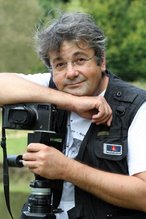

























Branimir Ritonja was born in 1961. He is a criminologist by profession. He gets his first camera in
Home page:
http://www2.arnes.si/~briton1/
Branimir Ritonja Photographer and Art Director of the Stolp Photo Gallery.


























Branimir Ritonja was born in 1961. He is a criminologist by profession. He gets his first camera in

Poetry of hidden glances
With the present exhibition Branimir Ritonja offers a mosaic of diary notes written in four European cities. The photographs have been taken on journeys between 2001 and 2006 and form four cycles that are not divided by motif but still show diverse impressions imposed on the photographer by the individual town. The main protagonists of the photographer's opus are
When strolling through the cities, which Branimir Ritonja caught in his objective, images are disclosed in front of us that we probably would not have noticed if we had visited these same cities ourselves. The artist namely searches for hidden nooks, reveals districts and views that usually remain concealed to the curious tourist. He searches for the city's soul far away from the glittering sightseeing and general points of interest. And he finds it: in unattractive streets and coincidental passers-by, in dilapidated buildings and everyday things. His photographs carry the spirit of timelessness; in some places the geographic appurtenance is effaced which gives us the feeling that the photograph could be taken anywhere. The black and white technique he uses gives the story uncompromisingly and with the necessary acuteness. In this way the contrasts are more distinct and the play of light and shadow more expressive and narrative. The poetics of Branimir Ritonja are marked by the geometry of sight. The picture opening in front of the beholder is cut up, often divided into several individual entities but always constructed in a way that its entirety is perfectly balanced and harmonious. The poetic everyday ceases entirely. The artist constructs the picture with the help of visual elements that attract the beholder and lead him through his photographs. With an exceptional feeling for composition and perspective he unites the intertwining lines and thus gives the images a new, deeper, symbolic meaning.
The artist plays with geometric forms and intertwines horizontal and vertical lines. An element, like a tree or a fence, is often placed in the forefront, which drags the view into the background. This characteristic is repeatedly shown on the majority of photographs exhibited. Another iconographic speciality of the works by Branimir Ritonja is the complex structure of the photographs. On first sight they seem like collages put together from different sights – the photograph's composition namely acts unusually. And yet it is a real view that only a trained photographer's eye is able to observe. Individual parts of the photograph are united in contrast, formal or contextual, but always in accordance with the balanced entirety. Thus old and new, remnants of the past and the contemporary spirit entering this space, organic and geometric shapes are combined, leading towards various interpretations that uplift the story to a symbolic level.
The photographs by Branimir Ritonja are marked by a solid and balanced construction. A compound of unusual sights and the uniting of contrasting forms ceaselessly attract the photographer's eye. It seems as the motif is not the most important carrier of the story, although releasing the trigger starts to weave an uncommon narration, through which these elements are not dispossessed of poetry but contribute to a greater expressiveness giving the photographs a special charm.
Maja Vuksanović
BRANIMIR RITONJA
Branimirja Ritonjo poznamo kot izvrstnega fotografa in zavzetega organizatorja, ki že nekaj let vodi Fotogalerijo Stolp v Mariboru.
V zadnjem obdobju lahko sledimo njegovim serijam in fotografskim instalacijam, kot so XPAN iz leta 2001, Sin Salida - Brez izhoda iz leta 2003,
Vse omenjeno velja tudi za pričujočo serijo Bratislava, nastalo leta 2005 med študijskim bivanjem v Bratislavi. Motive je Branimir "nabiral med sprehajanjem" in spoznavanjem mesta. Za ogled si moramo vzeti nekoliko več časa. Pogosto se moramo vprašati, kdo je na fotografiji in kaj oseba sploh počne ... da se razkrije nezdružljivost podob in okolja. Napetost med svetovi avtor doseže na pomenski ravni, kot je zelo očitno na fotografiji, kjer reklamni pano pokaže nov povsem bleščeč avto, ki ga primerja z okoljem, odpadom gum. Na drugi fotografiji avtor primera izložbo trgovine in človeka vsakdanjika, ki obrača pogled v nas, pri čem postane povsem jasno, da v trgovino kot kupec ne bo nikoli vstopil. Spet naslednjič pa se pomeni skrivajo v soočanju praznih stopnic, zarjavelih ključavnicah in modernih stavbah v bližini. Fotografija je pogosto razdeljena tudi s pomočjo likovnih sredstev, ustvarijo se napetosti med svetlimi in temnimi površinami, praznino in strukturo.
Branimirja Ritonjo privlačijo vzorci, njihovo razvrščanje, poigravanje z našim pogledom; poglejmo bogate strukture sten, ograje, električne napeljave, stebre, ki jih avtor spreminja v likovne elemente ... Serija je zanimiva tudi zaradi panoramskega fotoaparata. V sodobnosti aktualen pristop, ki zaobjame širši pogled, kot ga lahko vidimo s prostim očesom, pa je fotografu tokrat omogočil tudi nekaj povsem nepričakovanega - veliko bolj neposreden stik s portretiranci. Ti se ob pogledu na dokaj neprofesionalni videz fotoaparata niso počutili ogroženo in so vzpostavili spontan stik s fotografom, kar je danes že velika redkost.
Po eni plati se skozi serijo jasno kaže avtorjev intimen pogled, zato je skorajda vseeno, katero mesto je pred nami: v zadnjem času ga privlačijo zapuščeni predeli, malenkosti, obrobje ... Vendar je serija tudi potopis. Tokrat dvojnosti, ki ga privlačijo, ni podprl z izborom fotografskega papirja. Ker sicer tonsko izjemno bogat papir nima čiste beline in ne ponuja kontrastnosti, prevladuje sivina, ki določa celoto. Ker pa imamo pred seboj konkretno mesto, sklenimo: Bratislava je siva, kljub prenovljenemu centru ni slišati smeha in ni videti sonca.